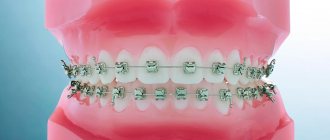In the modern world, a smile is considered a kind of calling card of every person. But unfortunately, not everyone can boast of straight white teeth, which they got thanks to their genes. Malocclusion or insufficiently straight teeth can cause disruption of the gastrointestinal tract.
In order to correct the bite even in adulthood, there is a special system - braces. Before and after using the structure, the smile changes significantly, and the bite is restored.
In the article we will talk about the treatment and illustrate it with many photographs in the style of what was then. Happy reading and viewing.
What are braces?
Braces, or rather brace systems, are dental structures for eliminating malocclusions and problems with incorrect position of teeth.
Alignment with orthodontic braces began to be practiced back in 1776 in France, but the heavy structures used then interfered with speech and extended beyond the mouth. More than a hundred years later, the device was radically improved in America. Today, the classic system looks different and consists of three main elements: ➢
braces - clasps that are attached to the teeth
➢
orthodontic arch
➢
fastenings (ligatures) for coupling the arch with the clasps
Main types of braces
Previously, when it was necessary to straighten with braces, for many patients the stopping factor was the aesthetic side of the issue - the structures were made exclusively of metal and were fixed on the outside of the teeth. Now there are many types of orthodontic systems to suit every taste. The main differences between braces are the installation methods and materials of manufacture.
External and internal braces
A frequent question from patients is whether it is possible to place braces on crooked teeth without others noticing. Internal, or lingual, braces allow you not to worry about the aesthetic aspect. Unlike external ones, lingual systems are fixed on the back of the teeth and are completely invisible to others. True, the patient takes longer to get used to the lingual system. But it is not always suitable for people with allergies, since it is made of metal, which can provoke an allergic reaction.
Ligature and non-ligature braces
Ligature and non-ligature systems differ in the method of attachment to the arch. The first ones are attached using clamps (ligatures), while the second ones are devices of a more advanced level that do not require additional fastenings. Ligature-free braces allow you to adjust the position of the arch once every 2-3 months. However, many specialists prefer monthly treatment monitoring. Despite their more advanced structure, it is difficult to say that non-ligature dental braces are more effective than traditional ones.
How safe is treatment with braces?
There is an assumption that braces have a harmful effect on the enamel, causing caries, causing demineralization of the enamel. In fact, negative processes can occur due to insufficient hygiene due to the formation of dental plaque that provokes infections. With high-quality installation and proper care, no negative effects of braces on the enamel and dental health have been identified.
Many myths are associated with the disadvantages of orthodontic treatment with braces, which actually exist, as well as with the features and disadvantages of individual braces. If we leave aside the aesthetic side of the issue, the main disadvantage of wearing braces is some complication of hygienic requirements. In practice, this only requires a lot of effort for high-quality teeth cleaning and special devices that can be easily purchased at any pharmacy.
Types of bracket systems
Some people don’t attach importance to the presence of a metal device in the mouth - back in the 90s, Cindy Crawford not only wore dental braces, but even starred in them in an advertising campaign for Pepsi Cola. For those who have chosen external orthodontic braces, but prefer not to advertise the treatment, there are other options.
Types of braces depending on material
- Plastic: the most budget braces - from 20,000 rubles. It is the plastic design that has become not just a device for dental treatment, but also an accessory that complements the image. Unfortunately, it also has many disadvantages: plastic is not the most durable material, in addition, such dental braces change color under the influence of coloring products.
- Metal: The most durable of all braces for straightening teeth, but they are not suitable for people with metal allergies. A steel system will cost 60,000 - 80,000 rubles, a titanium system - from 80,000 to 100,000 rubles. In terms of aesthetics, this is not the most advantageous design.
- Ceramic: highly aesthetic, matched to the color of the enamel, does not cause allergies, but is less durable than metal. In Moscow, the cost of ceramic braces is 40,000 - 70,000 rubles.
- Sapphire: the most aesthetic of all options. They look very impressive in the light, but if the patient’s teeth have a yellowish tint, you should carefully consider whether sapphire braces are needed, as they will stand out strongly. Also quite fragile. The cost of sapphire structures is 100,000 - 150,000 rubles.
How do girls transform?
It is no secret that it is the fair half of humanity that is most concerned with issues of their own appearance, so even small defects can be perceived as a tragedy on a universal scale, no less. What can we say about such troubles as protruding fangs, a protruding jaw or crooked teeth. Many girls demonstrate determination in terms of combating such defects, but only until the stage of choosing treatment options. Often they are afraid of the need to wear braces for a long time and the result obtained afterward is not always the motive that helps them overcome such fears.
It is worth saying that many men find girls with braces cute; they perceive these structures in a completely different way than the fair sex sees them. In addition, it should be added that the achievements of modern dentistry allow us to take a fresh look at the aesthetic component of the process of wearing braces. Metal has long been no longer the only and unalternative option; today, ceramic, plastic and sapphire systems, which are much less noticeable on human teeth, are widely used. In addition, there are also lingual braces that are installed on the inside of the jaw, which makes them completely invisible to others.
A way out can be found in almost any situation, and aesthetics should not become an obstacle to getting rid of malocclusions.
How do braces differ from each other?
| Type of braces | Materials | Differences | Price |
| Metal | metal alloy | reliable and cheap | from 50,000 rubles* |
| Ceramic | ceramics | the most inexpensive of aesthetic | from 70,000 rubles* |
| Sapphire | artificial sapphire | beautiful and relatively inexpensive | from 100,000 rubles* |
| Lingual | gold + metal | completely invisible | From 150,000 rubles* |
*Prices are indicative in Moscow and only for the bracket system.
How do braces straighten teeth?
It is designed by nature that our teeth can change position - independently or under the influence of external forces. Thanks to this property, orthodontic treatment with braces becomes possible. Its principle is the following.
- Based on the patient’s clinical picture, the doctor plans a trajectory of movement for each tooth; one bracket is responsible for one dental unit.
- During the process of fixing the braces, the clasps are connected to each other by an arch with shape memory, which it tends to take over time.
- Under the influence of the arc, the dentition begins to take the desired position.
- During treatment, the archwire is replaced with a more rigid one to increase the impact.
Installation process
The installation of an orthodontic structure is a very complex process; it requires great concentration and preliminary preparation. The installation is carried out in stages and is carried out only after all the necessary studies of the dentofacial system have been completed, as well as the obligatory sanitation of the oral cavity. The sequence of work usually looks like this:
- Impressions of the jaws are taken so that specialists in the dental laboratory can make a plaster model, on the basis of which an individual treatment plan is drawn up.
- The braces system itself is being manufactured.
- Next, the oral cavity is prepared, which includes sanitation, polishing and drying procedures.
- Fixation of braces using a special adhesive to each dental unit.
- The final stage will be the installation of the arc itself and its activation.
Sometimes a patient needs to install the system on both jaws at once; then the arch is initially attached to the upper jaw and only then to the lower jaw.
Indications and contraindications for installation
Problems that alignment with braces can help solve:
- crooked teeth due to improper growth
- displacement of the dentition as a result of the removal of dental units
- jaw development disorder
When there is crowding and gaps between teeth, braces are the optimal solution. In the latter case, it will not be possible to manage with orthodontic treatment alone; complex procedures with the participation of a surgeon will be required.
What can be achieved?
Many people think that after undergoing a course of treatment with braces, a person only gets straight teeth that look beautiful and natural . This is true, however, this is only part of what such orthodontic devices can provide.
First of all, chewing function is restored, which is more important than even the external beauty of the teeth. After all, chewing is the first stage in the digestion and assimilation of food.
It also eliminates the possibility of problems with the joint connecting the jaws. In addition to the alignment of the teeth themselves and their rows, the face changes, the lines become more regular and attractive.
All this relieves the patient from many psychological problems and complexes that arise due to malocclusions and pathologies.
At what age are braces placed?
The mobility of teeth in the jawbone persists throughout a person’s life, therefore, the answer to the question “Can braces be placed on crooked teeth in adulthood?” - positive. However, correcting a child’s bite with braces is much easier.
You can begin treatment as early as 9 years of age, even if not all baby teeth have been replaced by permanent teeth. The most optimal age for installing braces is 12 - 13 years old, but even at 30, braces will show good results. It will just take more time.
What about adults?
The opinion that braces are for children is fundamentally wrong, since they can be used to correct various dental defects at any age. It’s just that in childhood the result will be achieved faster, and the factor of aesthetics plays a lesser role for a person. For adults, the last aspect is perhaps even more important than for teenagers and young people, especially when it comes to representatives of public professions. Again, less noticeable designs made of ceramic or sapphire, as well as lingual systems, will come to the rescue. It is worth remembering that the older the person, the longer his treatment may be, but the main role here is played by the complexity of each specific case.
Braces for crowns, veneers, implants
Crowns are not a contraindication to orthodontic treatment. The best option for installing braces on crowns is a metal system. It will provide reliable adhesion to the artificial material of the prosthesis. If you need to install a brace system on the teeth that serve as support for the bridge, the doctor will simply remove the prosthesis and put temporary plastic crowns on the patient for the period of treatment.
As for veneers, if they are already on the teeth, this will not be a contraindication to installing a brace system. However, it is still better not to install veneers before braces, especially taking into account that an incorrect bite is, in principle, a contraindication to veneering.
With an implant, it is already more difficult to correct the bite with braces - the artificial root sits firmly in the bone and is not able to move except upward. If possible, it is better to correct the curvature of the dentition before installing an artificial root. However, if implants are already in place, orthodontic treatment can still be planned and successfully carried out.
Duration of treatment
How long do you wear braces? Treatment with ligature structures averages 2.5 – 3 years. Self-ligating devices are usually worn for 1 – 2.5 years. The duration of treatment depends on the model of braces, the experience of the doctor, the complexity of the clinical case and cooperation with the patient. If you do not wear elastics and do not follow the orthodontist's recommendations, treatment will slow down.
girl with Mini Diamond metal braces
The patient comes to the appointment with the regularity specified by the doctor. At the initial stage of treatment with a self-ligating brace system, the intervals between visits are 8 – 10 weeks. During the basic mechanics phase, the patient visits the orthodontist every month. When installing ligature structures, he comes for activation at least once a month at each stage of treatment.
teenagers with Ormco braces
Braces for extracted teeth
It is possible to install an orthodontic structure in the absence of one or more teeth, but it depends on the specific clinical picture. For example, it is quite possible to straighten a slight curvature in the frontal zone, even if there are no molars in the row. But is it possible to use braces to close a void when supporting teeth are missing? In this case, installing a system makes sense only if we are talking about 6, 7 and 8 teeth. If the figure eight (wisdom tooth) is missing, movement is impossible, since the chewing teeth will not be enough for full functioning.
Braces for one jaw and several teeth
If the patient is concerned about the curvature of, for example, only the upper teeth, fair questions arise. For example, why do you need braces on two rows of teeth? And do they put braces on one jaw? Installing only upper braces or only lower braces is indeed possible in the absence of global problems. It is important that the treatment gives an effective result without affecting the function of the jaw.
If a patient has several crooked teeth in one area, the doctor may suggest partial dental braces. They are installed on a specific area of the dentition for about six months.
People around you start to envy you kindly
Not many people can boast of a perfect smile, but only a few take on this problem. However, braces on an adult are causing others to think about going to the dentist again. Yes, people around you will pay attention to you more often; friends and acquaintances will begin to be interested in the details of the treatment, the sensations, and the cost of the design. One thing is for sure - they will respect you, because you care about your health and did what many do not dare to do. In addition, not everyone is ready to shell out more than 100 thousand rubles to correct their smile.
Contraindications for installing braces
The installation of braces on teeth can be hampered by relative and absolute contraindications.
Relative contraindications to braces can be eliminated. These include:
- low level of hygiene
- caries
- allergy to materials contained in braces
- periodontitis, periodontal disease
- bruxism
Absolute contraindications are serious health problems that make orthodontic treatment impossible. These include:
- oncological diseases
- epilepsy
- psychiatric disorders
- pathology of bone tissue
- alcohol and drug addiction
- venereal diseases
- blood diseases
- tuberculosis
- diseases of the immune and endocrine systems
Second month of treatment: correction of gross anomalies
The first changes become noticeable in the photo by the end of the second month. The orthodontic arch, after installation, repeated the shape of the abnormal bite, over time began to return to the originally specified state, corresponding to the correct bite. At the same time, under the force of her traction, the teeth also began to move in the right direction.
The first positive results are so impressive that some patients are ready to remove their braces at this stage. Of course, this is impossible. Orthodontic treatment initiates the natural biomechanical process of bone removal and growth, interrupting which will force the teeth to return to their original position.
Can I wear braces during pregnancy?
During pregnancy, women's dental tissue becomes more fragile, and there is a risk of damage to it by orthodontic construction. Can braces be installed during this period? Yes, but ideally it is better to have orthodontic treatment before or after pregnancy. If you already have braces on your teeth, you should definitely inform the orthodontist about the changes in your body. The doctor will prescribe a detailed diagnosis and decide whether braces and pregnancy are compatible.
If everything is in order, treatment with dental braces can be continued as usual. If the effectiveness of orthodontic treatment is questioned, the specialist will recommend removing the system and using retainers until the process can be resumed.
The most difficult period is the first 2–3 weeks
Correction of orthodontic defects is based on the use of natural processes occurring in the body. The first evidence of the beginning of correction is the so-called dissociation of the bite, when the dental ligaments and bone tissue are forced, under the influence of the orthodontic arch, to begin to work in a new way.
This process can become very unpleasant for an unprepared patient: during the first few days, the closing of the jaws completely disappears, muscles begin to ache, and constant aching pain in the teeth appears and increases. If you are not used to it, braces can rub your cheek, tongue or gums, and in some cases, gum inflammation can even occur.
In fact, such a shock state of the dental system serves as excellent confirmation that the process has begun. But there can be no talk of a visual effect in the first few weeks of treatment.
Result of wearing: before and after photos
The effect of wearing an orthodontic system is noticeable already in the first two months - gross violations are corrected. Next, the position of the teeth and roots is normalized. By about the eighth month, the entire dentition can be corrected with braces; the next stage begins—correction of the bite with braces. During the final stage, the teeth are “worked out” in detail so that they fit together perfectly.
The course of treatment does not end with removing braces. Next, the doctor uses special structures to stabilize teeth after braces - retainers. The device is installed on the inner side of the dentition for 2 - 4 years. The duration depends on the age of the patient (the younger he is, the shorter the period of wearing retainers) and the severity of the anomaly.
In some cases, orthodontic systems have a positive effect on more than just the position of teeth. After braces, the face becomes more toned and the cheekbones become more pronounced. While wearing the structure, other muscles begin to work, emphasizing what was not noticeable before.
Materials for production
In this design, the raw materials that were used in the manufacture of the structure are also important, since each material has its own properties and characteristics. The most common bracket systems are those consisting of materials such as:
- Plastic. A system made from this material is the most affordable, but is used only if the treatment period is short-term. This system is quite impractical because the plastic, absorbing dyes, changes color very quickly. And also the structure of this material is very rough, which leads to the accumulation of a large number of bacteria on its surface.
- Ceramics. This is a special type of ceramic that is used only in dentistry. It has a large margin of safety (only metal is stronger). Its surface is very similar to natural tooth enamel and has a matte surface, which allows you to make braces almost invisible.
- Metal. The arc and fastenings are made from this material. Only medical alloys that do not cause allergic reactions and are not rejected by the body are used for these purposes. They are also resistant to external influences.
- Sapphire. In dentistry, only artificially grown sapphires are used, namely their single crystals. This material transmits light well, which allows it to remain invisible on teeth with fairly light enamel. This design is more fragile in comparison with the others, but still copes with its main functions perfectly.
Orthodontics has advanced quite a lot in the 21st century, so structures are made from the most comfortable and safe materials, and the effect of wearing braces before and after can exceed all expectations, but for this you need to be patient and also follow all the instructions of your doctor.
Teeth after braces
Many patients fear the negative consequences of braces. It is known that dental braces complicate oral hygiene procedures. However, following the doctor’s instructions for dental care during the treatment period will help avoid exposure to carious bacteria. If caries does appear, in most cases the specialist will be able to carry out treatment without disturbing the braces.
When removing sapphire or ceramic braces, damage to the enamel is possible - during the procedure they can crumble, which significantly complicates the orthodontist’s work. If damage occurs, the defect can be easily corrected with a small restoration.
How to fix crooked teeth without braces?
Today, dentistry offers several alternative solutions that allow you to straighten teeth without braces:
- Restoration: correction of defects in the dental crown using composite materials. Provides quick results at an affordable price, but will last about five years, and the color of the material will change over time.
- Veneering: fixation of plates on teeth that are almost indistinguishable from natural enamel. The method is used instead of braces for small curvatures or large gaps and is not suitable if the patient has complex dental curvature or malocclusion.
- Installation of removable braces. Essentially, these are orthodontic structures that do not need to be worn constantly. However, calling them braces is not entirely correct; these are completely different systems.
Are there removable dental braces?
Removable orthodontic systems are divided into trainers, plates and aligners. However, only the latter can be considered an alternative to braces.
Aligners are special aligners made of plastic material that are invisible to others. They are able to quickly and comfortably correct almost any dental defect. The aligners are removed when eating and brushing your teeth, which is very convenient. The Invisalign® system is considered the best today - it allows you to cope with defects that previously could not be straightened without braces. The design is made individually for each patient, so its cost is quite high and amounts to about 250,000 rubles.
Despite the many positive qualities of removable systems, the patient should make the decision about whether to install braces or use other correction methods only together with the attending physician.
Do's and don'ts when straightening teeth with braces
Orthodontic treatment is a long and responsible process. At home, braces require compliance with a number of rules.
- Hard and sticky foods should be excluded from your diet to avoid damaging your dental braces or getting food stuck in them.
- Sudden changes in temperature in the oral cavity should not be allowed (that is, ice cream should not be washed down with hot tea). This affects the elasticity of the orthodontic arch and can lead to the clasp coming off.
- To prevent ceramic or plastic braces on your teeth from staining, you should avoid coffee, jam, wine and drinks with dyes. Smoking also causes the system to change color.
- The oral hygiene procedure should be carried out using an irrigator, floss (dental floss) and a special brush with V-shaped bristles. Oral care is necessary after every meal.
- If the braces are loose or come off, there is no need to worry - just consult a doctor, and he will easily and quickly correct the situation.
At first, after you start correcting your teeth with braces, all these restrictions may seem quite burdensome and make you think: was it worth getting braces? However, the patient gets used to them very quickly. In addition, the result of the treatment definitely justifies all these not so pleasant nuances.
Important!
Is it possible to do an MRI with braces? If a patient with an orthodontic device is undergoing an MRI of the brain or jaw, the doctor should be informed about the presence of the system. Metal braces can distort diagnostic results. However, undergoing an MRI in braces does not pose any danger to the body.
Features of caring for braces
In order to minimize the possible risks of damage to the teeth and the braces themselves, it is necessary to adjust the diet in terms of eliminating products with a viscous consistency that can stick to the teeth and can complicate care, provoking the development of caries:
- sweet bakery products;
- confectionery products, sweets;
- chips, snacks, sweet sticks.
Solid food should be crushed to avoid increased stress on the structures when biting. It is recommended to completely avoid sugary carbonated drinks in order to prevent tooth demineralization.
In terms of hygiene, there is a standard list of care rules taking into account the types of braces installed:
- You need to brush your teeth regularly and be sure to do so after every meal;
- use special tactics for cleaning braces, since these are the critical areas;
- It is recommended to undergo professional cleaning once every two to three months;
- use special hygiene products: floss, orthodontic brushes, irrigators.
Using all of the above recommendations eliminates any possible harm from the use of braces and is guaranteed to preserve the health, attractiveness and flawlessness of your teeth.
Photos before and after
It is impossible to create a truly Hollywood smile without straightening your teeth and correcting your bite. Therefore, if a patient has orthodontic problems, braces are included in the mandatory treatment plan. Incorrect bite and crooked teeth are one of the main contraindications for the installation of aesthetic restorations. If you ignore orthodontic treatment and proceed straight to veneering, the veneers simply will not stick to the teeth. This fact is confirmed by personal example by many celebrities who, for the sake of a perfect smile, put braces on their teeth.
Tom Cruise decided to fix his teeth with braces only after 40 years.
After the breakup of the Spice Girls, Melanie Jane Chisholm had to seriously work on her image, and, above all, straighten her teeth.
Cristiano Ronaldo was not always handsome, as his impeccable smile might lead you to believe. According to rumors, he spent more than a million euros on teeth straightening and other procedures.
Price for braces in Moscow
As a rule, the cost of braces in Moscow is formed from the price of the system itself, as well as the total costs of installation and further treatment. The cheapest braces are, of course, metal. Their price starts from 50,000 rubles. Relatively inexpensive ceramic systems that cost about 75,000 rubles. The cost of a sapphire bracket system starts from 85,000 rubles. You need to be careful here, as ceramics are sometimes passed off as sapphire. The most expensive will be lingual systems, especially if they are made to order, their approximate price starts from 100,000 - 150,000 rubles. When figuring out the cost, be sure to ask what is included and what services will need to be paid additionally. It happens that the initially low price of braces increases significantly during the treatment process. However, when choosing an orthodontist and a braces system, you should not focus solely on cheaper or more expensive; remember that poor-quality orthodontic treatment is fraught with a lack of results and the occurrence of a number of complications.
| A country | Manufacturer | Manufacturing materials | Price |
USA | 3M Unitek | Metal braces | from 25,000 rubles |
| Ceramic braces | from 70,000 rubles | ||
| Sapphire braces | from 80,000 rubles | ||
| Ormco | Metal braces | from 20,000 rubles | |
| Ceramic braces | from 45,000 rubles | ||
| Sapphire braces | from 50,000 rubles | ||
| American Orthodontics | Metal braces | from 40,000 rubles | |
| Ceramic braces | from 70,000 rubles | ||
| Sapphire braces | from 50,000 rubles | ||
| Ortho Technology | Metal braces | from 15,000 rubles | |
| Ceramic braces | from 35,000 rubles | ||
| Sapphire braces | from 40,000 rubles | ||
| The Dentsply GAC | Metal braces | from 20,000 rubles | |
| Ceramic braces | from 30,000 rubles | ||
Germany | TOP-Service für Lingualtechnik GmbH | Gold-platinum alloy braces (lingual only) | from 175,000 rubles |
| Forestadent | Metal braces | from 30,000 rubles | |
| Ceramic braces | from 60,000 rubles | ||
| Sapphire braces | from 90,000 rubles | ||
Korea | HT Corporation | Metal braces | from 20,000 rubles |
| Sapphire braces | from 30,000 rubles | ||
Italy | SIA Orthodontic | Metal braces | from 20,000 rubles |
| Ceramic braces | from 25,000 rubles | ||
Most Popular Brands
DamonQ
photo: during and after treatment with Daimon Q braces
This is a passive self-ligating metal system, which is characterized by its miniature elements. The smoothness of the lines ensures wearing comfort and ease of care.
Clarity
photo: before and after treatment with the clarity system
Ceramic braces that also contain metal. This is what distinguishes them from most aesthetic designs. Clarity braces feature a reinforced metal slot that increases strength and durability while reducing archwire friction.
Incognito
photo: treatment in adults, after 6 months
These are lingual braces that are completely custom made . For each tooth, the required shape of the bracket and the exact location of attachment are calculated separately. Another difference is that a gold alloy is used for production, which practically does not cause allergies.
In-ovation
photo: during treatment
Ligature-free braces. Three modifications are presented:
- R is a metal vestibular design with a unique locking clasp that speeds up the installation process.
- C – ceramic braces, which are reinforced with a thin layer of zirconium dioxide.
- L – lingual system with an individual approach.
STB
photo: before and after 6 months of treatment
Lingual braces are made of durable metal alloy. They are distinguished by their minimal dimensions and special very low attachment to the base of the tooth , which allows the main load to be directed precisely to this part.










